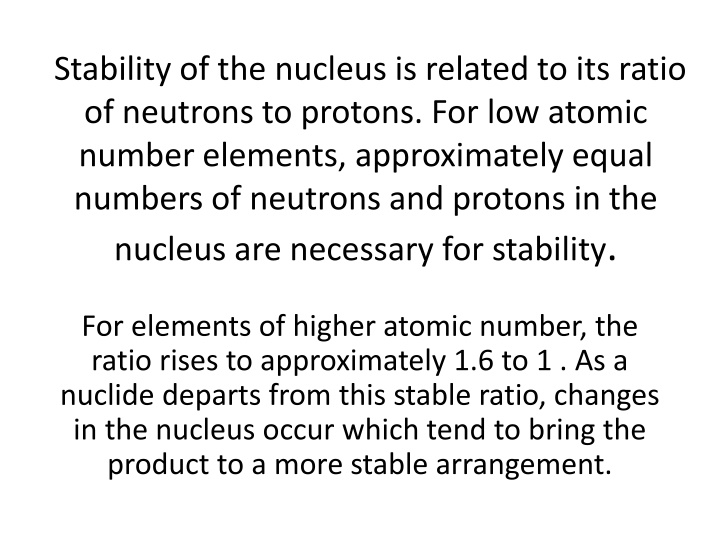
Nucleus Stability and Radioactive Decay
Exploring the relationship between neutron-to-proton ratio and nucleus stability, the process of Beta Decay, and the emission of high-energy beta particles in radioactive nuclei. Learn how changes in the nucleus aim to achieve a more stable arrangement.
Download Presentation

Please find below an Image/Link to download the presentation.
The content on the website is provided AS IS for your information and personal use only. It may not be sold, licensed, or shared on other websites without obtaining consent from the author. If you encounter any issues during the download, it is possible that the publisher has removed the file from their server.
You are allowed to download the files provided on this website for personal or commercial use, subject to the condition that they are used lawfully. All files are the property of their respective owners.
The content on the website is provided AS IS for your information and personal use only. It may not be sold, licensed, or shared on other websites without obtaining consent from the author.
E N D
Presentation Transcript
Stability of the nucleus is related to its ratio of neutrons to protons. For low atomic number elements, approximately equal numbers of neutrons and protons in the nucleus are necessary for stability. For elements of higher atomic number, the ratio rises to approximately 1.6 to 1 . As a nuclide departs from this stable ratio, changes in the nucleus occur which tend to bring the product to a more stable arrangement.
RADIOACTIVE DECAY Beta Decay When the neutron to proton ratio is too high, a neutron "transforms" into a proton and electron, with the electron being ejected from the nucleus. The ejected electron is called a "beta particle".
Beta particles are not emitted with a single energy but are emitted with a spectrum of energies up to some maximum value. This is due to a division of the total energy of each disintegration between the beta particle and a neutrino, which is another particle that is emitted at the same time as the beta particle. The neutrino has a negligibly small mass and no charge, and it carries off varying amounts of the released energy.
It therefore travels great distances, losing little energy in nearby materials and causing no biological damage. Beta particles are high- energy, high- speed electrons or positrons emitted by certain types of radioactive nuclei






















